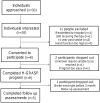H-GRASP: the feasibility of an upper limb home exercise program monitored by phone for individuals post stroke
- PMID: 27017890
- PMCID: PMC5399812
- DOI: 10.3109/09638288.2016.1162853
H-GRASP: the feasibility of an upper limb home exercise program monitored by phone for individuals post stroke
Abstract
Purpose: To investigate the feasibility of a phone-monitored home exercise program for the upper limb following stroke.
Methods: A pre-post double baseline repeated measures design was used. Participants completed an 8-week home exercise program that included behavioural strategies to promote greater use of the affected upper limb. Participants were monitored weekly by therapists over the phone. The following feasibility outcomes were collected: Process (e.g. recruitment rate); Resources (e.g. exercise adherence rate); Management (e.g. therapist monitoring) and Scientific (e.g. safety, effect sizes). Clinical outcomes included: The Chedoke Arm and Hand Inventory, Motor Activity Log, grip strength and the Canadian Occupational Performance Measure.
Results: Eight individuals with stroke were recruited and six participants completed the exercise program. All but one of the six participants met the exercise target of 60 minutes/day, 6 days/week. Participants were stable across the baseline period. The following post-treatment effect sizes were observed: CAHAI (0.944, p = 0.046); MALQ (0.789, p = 0.03) grip strength (0.947, p = 0.046); COPM (0.789, p = 0.03). Improvements were maintained at three and six month follow ups.
Conclusions: Community dwelling individuals with stroke may benefit from a phone-monitored upper limb home exercise program that includes behavioural strategies that promote transfer of exercise gains into daily upper limb use. Implications for Rehabilitation A repetitive, task-oriented home exercise program that utilizes telephone supervision may be an effective method for the treatment of the upper limb following stroke This program is best suited for individuals with mild to moderate level impairment and experience a sufficient level of challenge from the exercises An exercise program that includes behavioural strategies may promote transfer of exercise gains into greater use of the affected upper limb during daily activities.
Keywords: Rehabilitation; stroke; telemedicine; upper limb.
Figures



Similar articles
-
The feasibility of the adapted H-GRASP program for perceived and actual daily-life upper limb activity in the chronic phase post-stroke.Disabil Rehabil. 2024 Dec;46(24):5815-5828. doi: 10.1080/09638288.2024.2313121. Epub 2024 Feb 8. Disabil Rehabil. 2024. PMID: 38329448
-
Home-based Computer Assisted Arm Rehabilitation (hCAAR) robotic device for upper limb exercise after stroke: results of a feasibility study in home setting.J Neuroeng Rehabil. 2014 Dec 12;11:163. doi: 10.1186/1743-0003-11-163. J Neuroeng Rehabil. 2014. PMID: 25495889 Free PMC article. Clinical Trial.
-
Modified Constraint-Induced Movement Therapy is a feasible and potentially useful addition to the Community Rehabilitation tool kit after stroke: A pilot randomised control trial.Aust Occup Ther J. 2018 Dec;65(6):503-511. doi: 10.1111/1440-1630.12488. Epub 2018 Jun 19. Aust Occup Ther J. 2018. PMID: 29920688 Clinical Trial.
-
Do trunk exercises improve trunk and upper extremity performance, post stroke? A systematic review and meta-analysis.NeuroRehabilitation. 2018;43(4):395-412. doi: 10.3233/NRE-182446. NeuroRehabilitation. 2018. PMID: 30400112
-
Prescribed exercise programs may not be effective in reducing impairments and improving activity during upper limb fracture rehabilitation: a systematic review.J Physiother. 2017 Oct;63(4):205-220. doi: 10.1016/j.jphys.2017.08.009. Epub 2017 Sep 21. J Physiother. 2017. PMID: 28941967
Cited by
-
Relationship Between Body-Specific Attention to a Paretic Limb and Real-World Arm Use in Stroke Patients: A Longitudinal Study.Front Syst Neurosci. 2022 Feb 22;15:806257. doi: 10.3389/fnsys.2021.806257. eCollection 2021. Front Syst Neurosci. 2022. PMID: 35273480 Free PMC article.
-
A systematic review of measures of adherence to physical exercise recommendations in people with stroke.Clin Rehabil. 2019 Mar;33(3):535-545. doi: 10.1177/0269215518811903. Epub 2018 Nov 21. Clin Rehabil. 2019. PMID: 30458647 Free PMC article.
-
Domiciliary VR-Based Therapy for Functional Recovery and Cortical Reorganization: Randomized Controlled Trial in Participants at the Chronic Stage Post Stroke.JMIR Serious Games. 2017 Aug 7;5(3):e15. doi: 10.2196/games.6773. JMIR Serious Games. 2017. PMID: 28784593 Free PMC article.
-
Implementation and Evaluation of the Graded Repetitive Arm Supplementary Program (GRASP) for People With Stroke in a Real World Community Setting: Case Report.Phys Ther. 2021 Mar 3;101(3):pzab008. doi: 10.1093/ptj/pzab008. Phys Ther. 2021. PMID: 33444440 Free PMC article.
-
Use of real-time multimodal sensory feedback home program improved backward stride and retention for people with Parkinson Disease: A pilot study.Clin Park Relat Disord. 2022 Jan 15;6:100132. doi: 10.1016/j.prdoa.2022.100132. eCollection 2022. Clin Park Relat Disord. 2022. PMID: 35128375 Free PMC article.
References
-
- Lawrence ES, Coshall C, Dundas R, et al. . Estimates of the Prevalence of Acute Stroke Impairments and Disability in a Multiethnic Population. Stroke. 2001;32:1279–1284. - PubMed
-
- Kwah LK, Harvey LA, Diong J, et al. . Models containing age and NIHSS predict recovery of ambulation and upper limb function six months after stroke: an observational study. J Physiother. 2013;59:189–197. - PubMed
-
- Taub E, Uswatte G, Mark VW, et al. . The learned nonuse phenomenon: implications for rehabilitation. Eura Medicophys. 2006;42:241–255. - PubMed
-
- Rand D, Eng JJ. Predicting daily use of the affected upper extremity 1 year after stroke. J Stroke Cerebrovasc Dis. 2015;24:274–283. - PubMed
MeSH terms
LinkOut - more resources
Full Text Sources
Other Literature Sources
Medical
Miscellaneous
